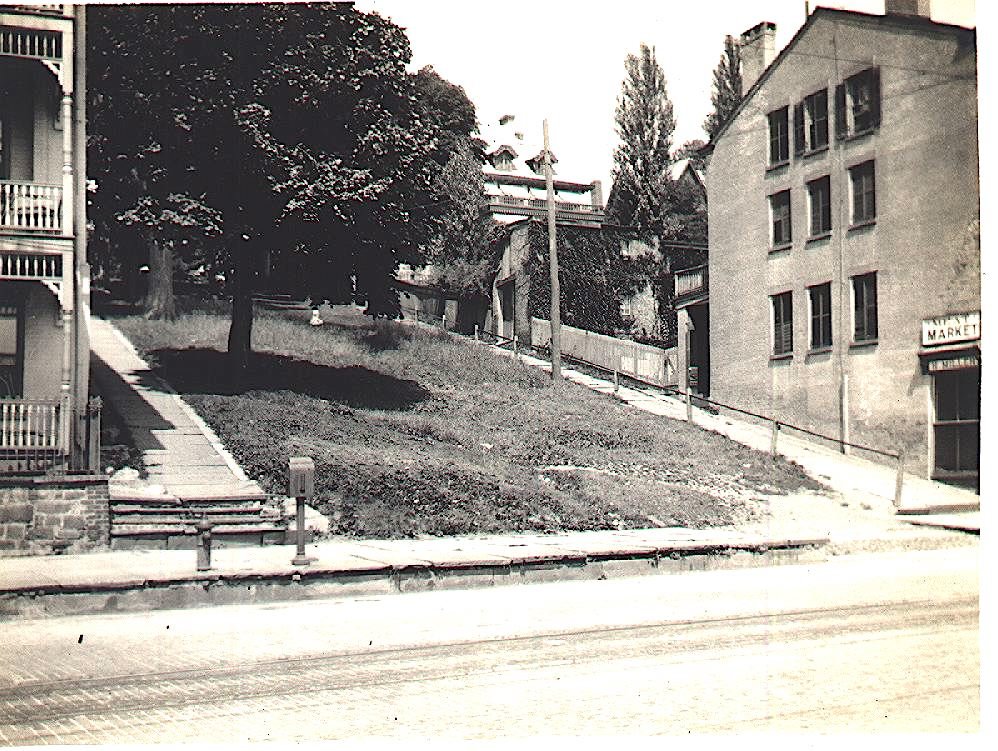
Clinton Street hill where it began at Water Street. Apartment porches of the 1837 former church on the left and a grocery on the right. Note the handrails common on Newburgh’s steepest sidewalks.
By Mary McTamaney
I stopped recently to watch construction crews finishing work at the house situated on the northeast corner of Clinton and Grand Streets. Mayor Mary Crabb lived there for many years and, after her death, it suffered a fire and was abandoned. Now it is coming back to life as apartments. All over Newburgh, the sounds of saws and hammers can be heard as old buildings are rehabilitated for yet another generation of residents. Like Mary Crabb’s former home, our structures are again reaching their rehabilitation ages. Nothing stands forever without vigilant repair and, as my husband and I discovered thirty-five years ago, when one repair problem is exposed, others jump out and shout for attention. In our case, a new shower turned into a major remodel when we saw the rotted iron and lead pipes in our walls.
I went to the library and looked through old city directories to learn about 73 Clinton Street (the former Crabb home) and discovered many things. First, street numbers have been changed over time which makes a search much harder when you must mentally walk uphill counting the listed dwellings between each intersection. Several buildings have disappeared and some have morphed from unnumbered utility structures into homes. Clinton Street is a good case study for this constant transformation through the decades. The side yard of the former Crabb house, for example, once held a huge old antebellum house. In the 1860’s it was a school for “young ladies” run by a Miss H. M. Parkhurst. Since students could board at Miss Parkhurst’s, that structure (addressed in the 1860’s as #78 Clinton Street) was already in its second life, perhaps remodeled with the addition of a third floor. A fire in the 1970’s when the 25-room building held apartments and rented rooms, took it from our landscape and former Mayor Crabb was able to buy the empty lot making it part of her corner home.
Just down Clinton Street nearer Montgomery, people now live in a comfortable brick house that was remodeled from its first life as a stable. It is easy to forget about one large population that was quickly displaced in early 20th century Newburgh: horses. So many households owned a horse and usually a small wagon or carriage as well in the years before public transit. Those wagons and their draft horses usually lived in the yards of their owners. Maps up to 1900 show hundreds of sheds and barns tucked behind local houses. A trustee of the Newburgh Historical Society recently uncovered a fuzzy old picture that shows 70 Clinton Street with its barn door and the small, high windows of horse stalls all along the exterior brick walls. Now it is a lovely one-family home with a wide front porch and completely different door and window pattern from its early time as a stable.
Clinton Street, named after New York’s first governor, George Clinton from Newburgh, is one of the city’s oldest east-west thoroughfares. It follows the steep rise of the landscape from the river and used to run from Water Street to Liberty Street and then was extended into the hillside that was the McAlpin estate and became the Dominican Sisters convent and school, Mt. St. Mary. Clinton Street for generations was anchored by one more interesting building that grew through many purposes: #245 Water Street, the southwest corner of the intersection with Clinton. Today it is part of the acres of downtown grass where it is hard to even imagine intersecting streets. But for generations that corner held an impressive big brick building that had been constructed in 1837 as the Union Presbyterian Church, then sold to the owners of the Steam Mills to be used as a social hall for their hundreds of workers. In the late 19th century, it went through a massive remodel, including the addition of wide front porches. It became apartments known by the name of the previous use of the building as a bible study center - the Bethel Mission Apartments. Six families lived inside its old brick walls until Water Street disappeared during the 1960’s. Urban Renewal was a massive failure at that time. Perhaps the sound of today’s saws and hammers is the slow return of hope we had nearly lost.